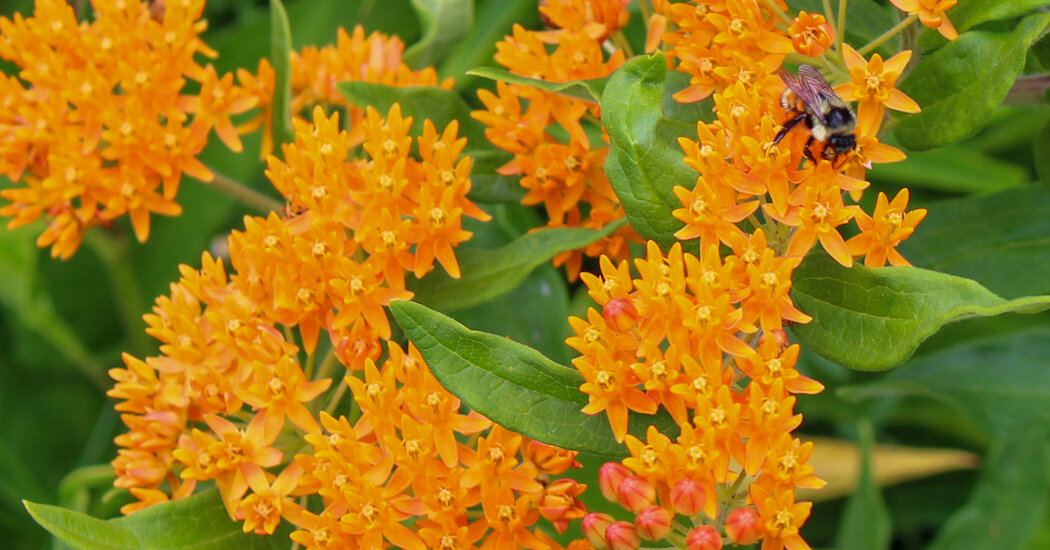
The native perennial species of our meadows — milkweeds, asters, Joe Pye weed and others — will make one more offering in fall, as if they haven’t given enough already. They will offer up their seed.
Gardeners can nurture the next generation by collecting some of it, and propagating more of their favorite wildflowers. But there’s a little wrinkle.
“Everything about sowing native seeds is counterintuitive to what people have been taught in horticulture,” said Heather McCargo, who founded the nonprofit Wild Seed Project in Maine in 2014.
Sowing wildflower seeds requires a shift in the how-to mind-set centered around the late-winter-into-spring ritual of sowing vegetables and annual flowers, she said.
That’s because wildflowers are sown at a different time: from late November to early January. They’re sown outdoors, not inside under lights. And they’re not sown one lonely seed or two per cell in six-packs, like lettuce or kale. Instead, they are sown thickly, into pots or open flats.
As Ms. McCargo put it: “Native seeds are like teenagers. They love to be together.”
She would like to see more of us learn the simple skills required to propagate native plants — and use them to repopulate the landscape with homegrown natives. That is the mission of Wild Seed Project, one that the organization sees as increasingly urgent in the face of a fast-shifting climate, with so much diversity at risk.
“Sowing seeds is like becoming a plant midwife,” said Ms. McCargo, who has been at it for more than 35 years, as native plant populations have shrunk alarmingly. Her hands-on experience includes five years as the head propagator at Garden in the Woods, in Massachusetts, the headquarters of Native Plant Trust.
“Everybody wants to just toss seeds into the landscape, but the life of a wild seed is fraught with risk,” she said. “Most land where it’s too wet or dry, or where a bird or mouse eats it.” The majority of seeds dispersed that way never become full-grown plants.
But if you collect seeds in a timely manner and sow them in a protected way — using basic tactics like rodent-proofing the nursery bed with mesh sheeting — “you can have a plant from each seed,” she said. A small pinch of seed can yield 50 or more plants for your garden, or for a community planting at a school or park.
Start With Easy Meadow Perennials
In its programs and publications and on its website, Wild Seed Project encourages gardeners to propagate a diversity of native plants, from bloodroot in the springtime all the way up to oak trees. But maybe the easiest to start with, Ms. McCargo said, are the wildflowers of summer-into-fall meadows, whose seeds ripen in autumn.
The most willing include Penstemon, bee balm (Monarda), asters and milkweeds (butterfly weed, Asclepias tuberosa, and swamp milkweed, A. incarnata). Blue flag iris (Iris versicolor), cardinal flower and blue lobelia (Lobelia cardinalis and L. siphilitica), blue vervain (Verbena hastata), goldenrods (Solidago), ironweed (Vernonia), Echinacea, Rudbeckia, Liatris and Joe Pye weed (Eutrochium purpureum) are likewise on her easy list.
First, though, a caveat about collecting the seeds: It is unethical, and often illegal, to gather seed on public lands or in the wild — and often even from somewhere as seemingly innocuous as by the roadside.
Gather seed in your own garden if you have wild-type plants or those that are close to the way nature made them, as hybrids and certain cultivars created by selection may not produce consistent results. Some will be sterile, good neither for sustaining pollinators nor for propagating. If a neighbor has a meadow, ask for permission to collect seed. And wherever you collect seed, do not gather more than 5 percent of any population of a plant in a single season, Ms. McCargo said.
A shortcut for those getting started: Wild Seed Project sells seed appropriate for fall sowing, starting in mid-September. Other sources of ethically produced, wild-type seed include Prairie Moon Nursery and Prairie Nursery.
Is the Seed Ready Yet?
The seed of various species ripens from September through November, and knowing when it is ready for harvest requires close observation from the time the flowers fade. Not every plant — or even every flower on a given plant — will mature at the same moment.
But each species has a “tell,” and firsthand experience will familiarize the beginning seed collector with the subtleties.
If the plant has a pod, like milkweed, look for a change from green to tan and papery, Ms. McCargo said. If the pods haven’t split on their own, gently squeeze one. If it splits, the seeds are ready.
Others, like Penstemon, have small, podlike seed capsules that get brown and woody. To gauge their ripeness, Ms. McCargo looks to see if a little hole on the top of each capsule has opened a bit, revealing tiny seeds inside.
Another visual cue is if most of the seeds are no longer whitish or greenish, but brown, tan or black.
Often the sense of touch, rather than sight, is the collector’s most helpful tool. Many meadow seeds have a fluffy appendage to carry ripe seeds in the wind, Ms. McCargo said, including aster, ironweed, Joe Pye weed and goldenrod. Generally, ripe seeds will come off if you brush your hand across the fluffy seed head. If the plant doesn’t release its seeds, leave them to ripen a bit longer.
But keep your hands off until you put a paper bag or envelope under any spent flower you’re examining, to catch the seeds that do let go. (An envelope is better for small, almost dust-like seeds, like those of Monarda or Lobelia.) And be sure to label each collection right away.
Before sowing the seeds, let them dry in their bags for a month or more, in a cool spot. This after-ripening period is critical for the seed to finish maturing before it is sown between late November and early January. Wild Seed Project does its big annual sowing around New Year’s Day.
Make a Little Nursery
You won’t need much gear to create a mini-nursery in your backyard. Choose a level spot appropriate for overwintering the sown flats or pots. Identify a shady location, because when spring’s strengthening light and higher temperatures arrive, the containers will dry out fast otherwise — and seeds that dry out will die.
The containers can simply be tucked under a garden bench, but an unused cold frame with a glass or plexiglass lid that can be removed or left open would also work. Or you could build a simple wooden frame, like the one you’d use for a raised garden bed.
The pots, grouped together inside a frame or not, must be covered with hardware-cloth screening of half- or quarter-inch mesh, weighted down with bricks, to protect them from rodents.
Assemble your other supplies, including nursery flats with drainage holes, or plastic pots four to six inches in diameter and at least three inches deep. Avoid peat or fiber pots. Also required: plastic labels and a pencil.
For potting medium, a compost-based potting soil is recommended, as well as a bag of clean, coarse all-purpose sand (available at hardware stores) to cover sown seeds. To provide gentle watering that doesn’t wash the seeds away, use a watering can with a rain nozzle.
Step-by-Step Propagation
Moisten the potting medium slightly, then fill each container, packing the mix until the surface is flat and reaches about a half inch from the rim. Mark each label with the species and sowing date, and insert it firmly inside the edge of the container before sowing.
Spread the seeds thickly but evenly on the soil surface, about an eighth to a quarter of an inch apart. Then cover them by sprinkling the sand to a depth roughly equivalent to the thickness of the particular seed.
“A pea would be covered with about a half inch of sand,” Ms. McCargo said, “compared to a sesame-size seed that would get only an eighth of an inch.”
Water thoroughly but gently, and move the pots into their nursery area outdoors, covering them with the wire mesh.
And there they stay, rain or snow, all winter, their protective seed coats gradually worn down by the freezes and thaws.
Indoors, all the while, you practice patience, and have faith.
“The seeds know what to do and when to do it,” Ms. McCargo said.
The next spring, each one will sprout in its own time. Resist dividing them too soon, although a potful of seedlings can be moved as a clump into a bigger pot, if necessary. In September, divide and plant the individual seedlings in their permanent homes. (More details here.)
Until recently, Ms. McCargo ran Wild Seed Project day-to-day, but now a staff of four, including a full-time director, means she can focus on her primary passion: expanding the seed nursery, and inspiring individuals and nurseries to sow natives — including oaks, maples and other native trees.
“Nobody should graduate from sixth grade without knowing how to germinate a tree seed,” she said. “Our native plants are losing their place in the world, and this is an action we can each take.”
Margaret Roach is the creator of the website and podcast A Way to Garden, and a book of the same name.
For weekly email updates on residential real estate news, sign up here. Follow us on Twitter: @nytrealestate.




